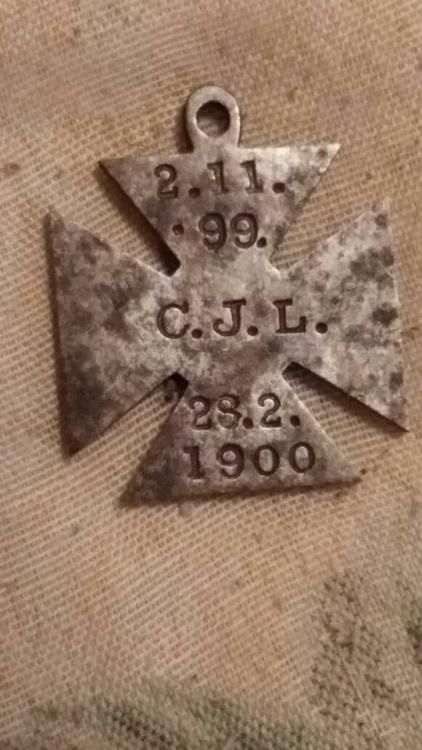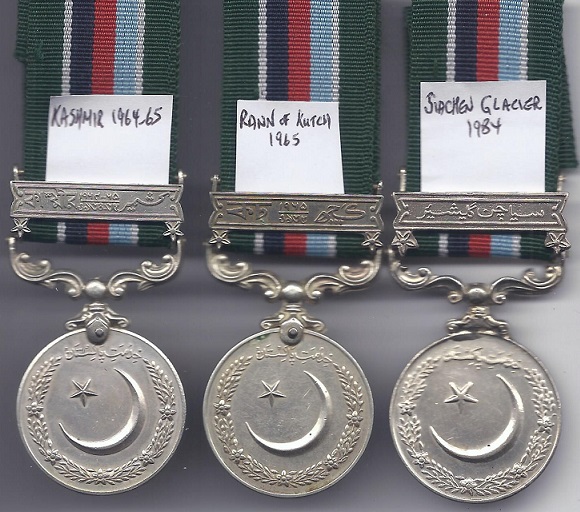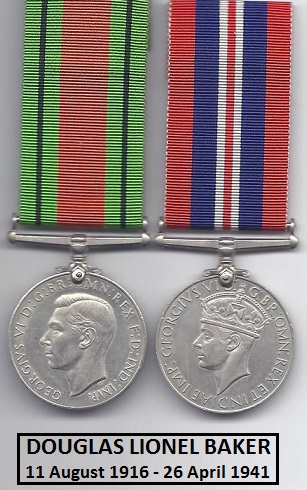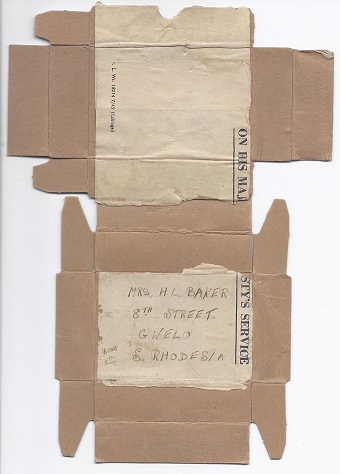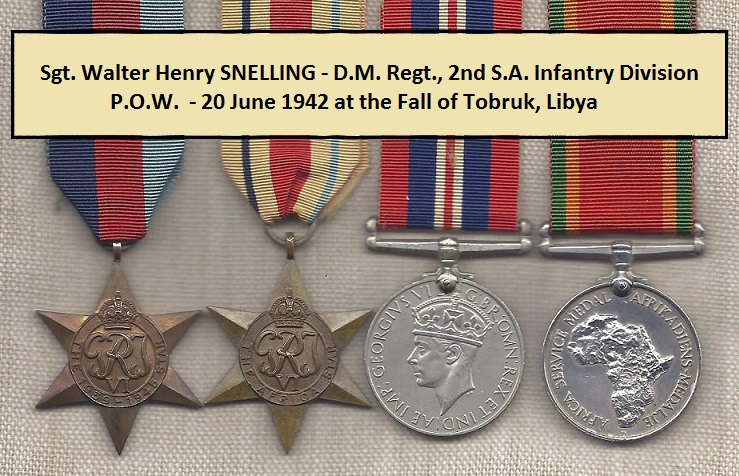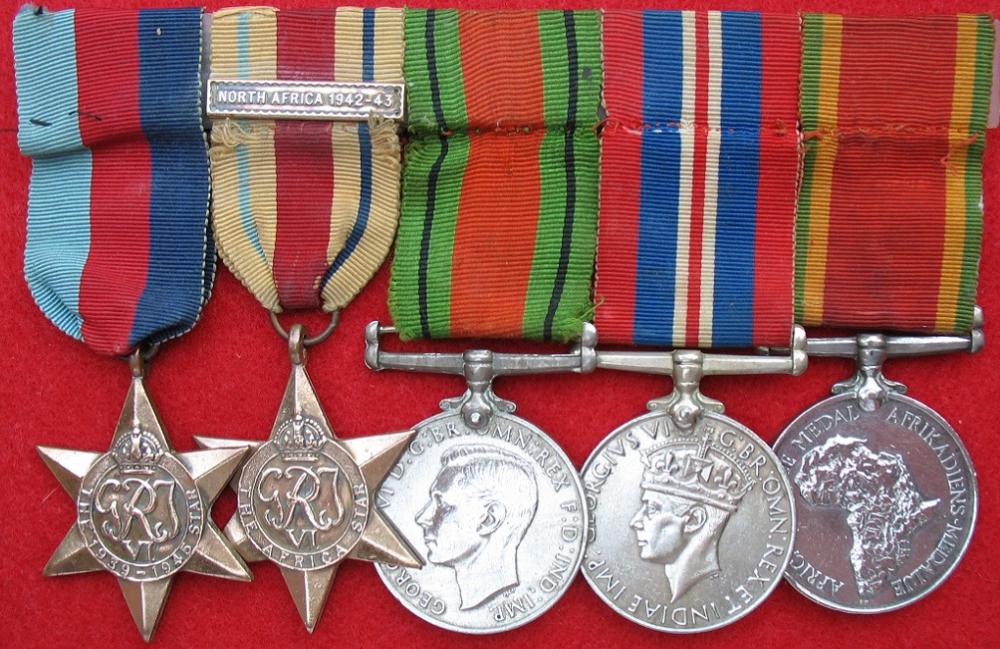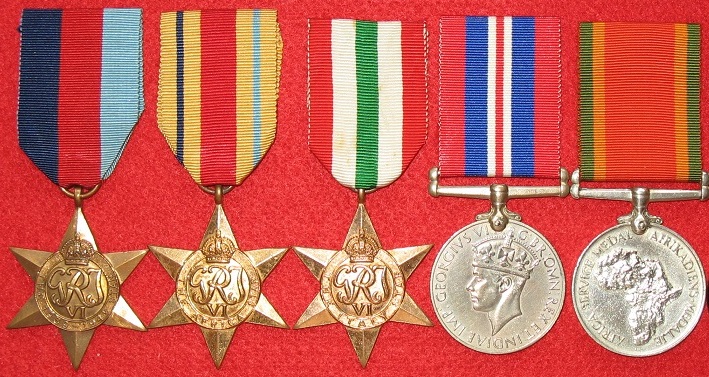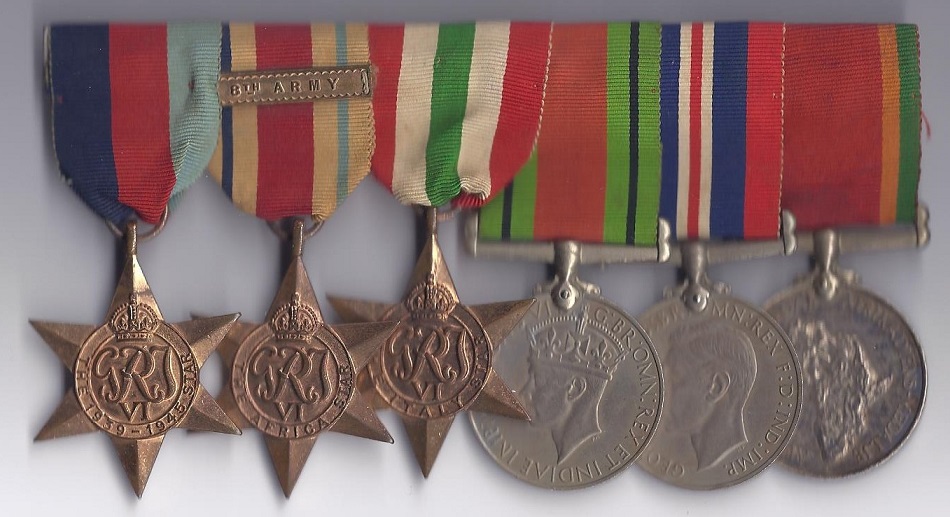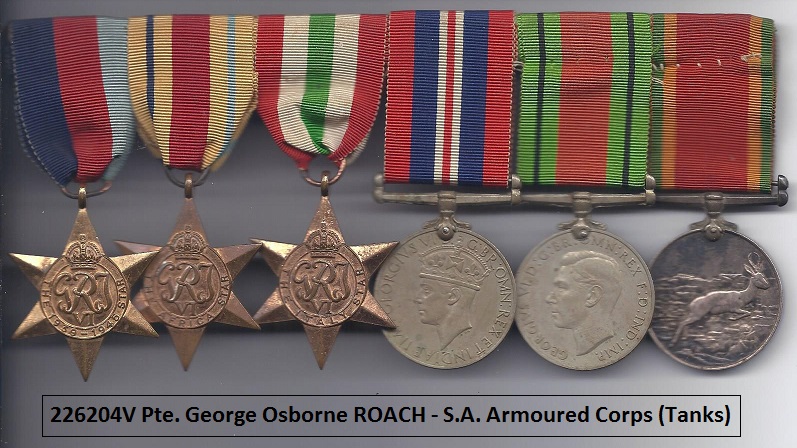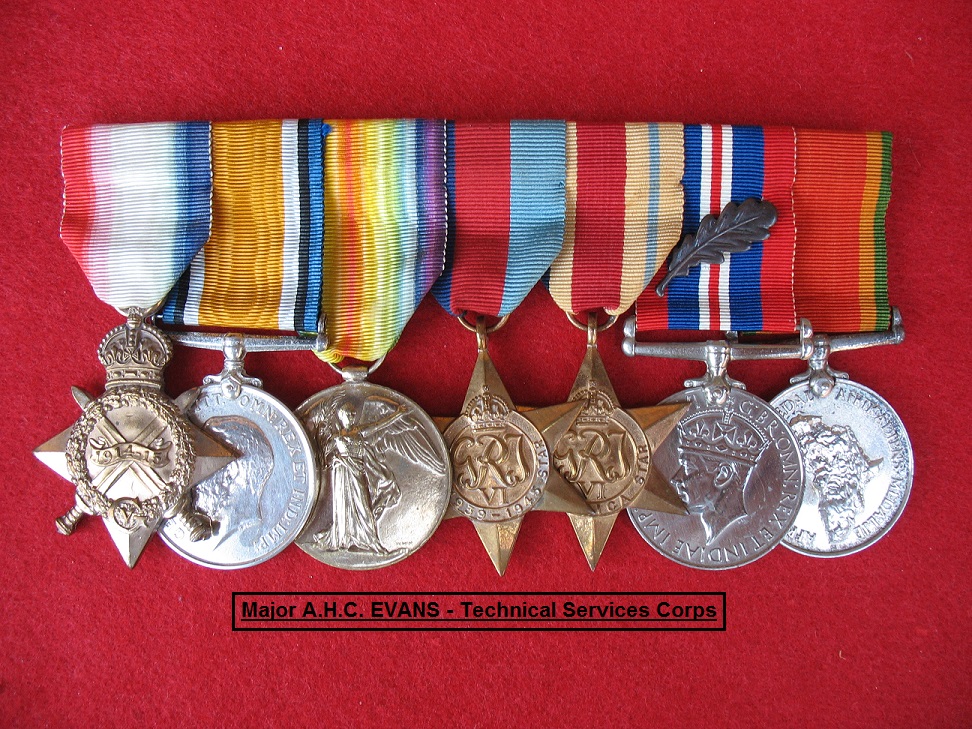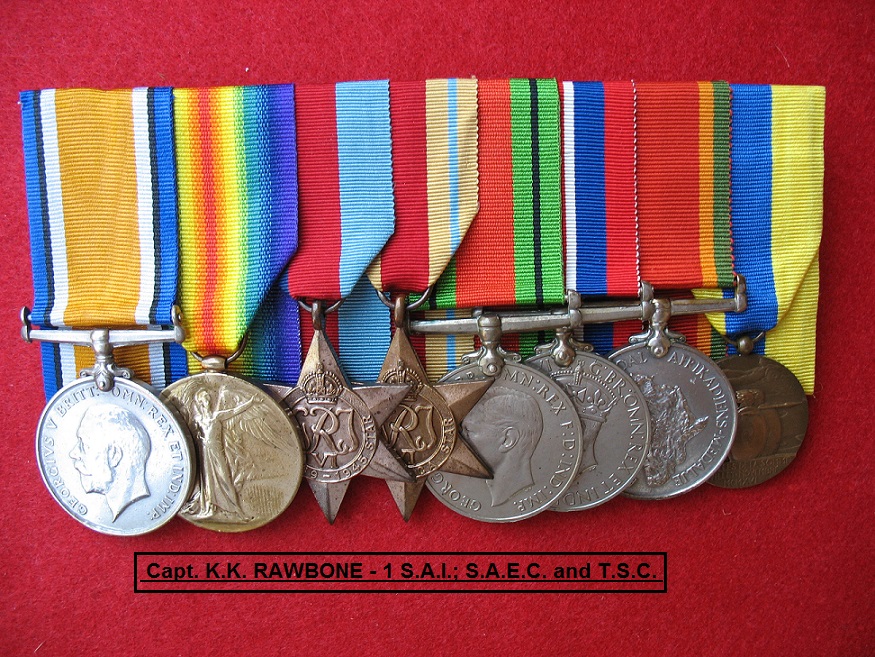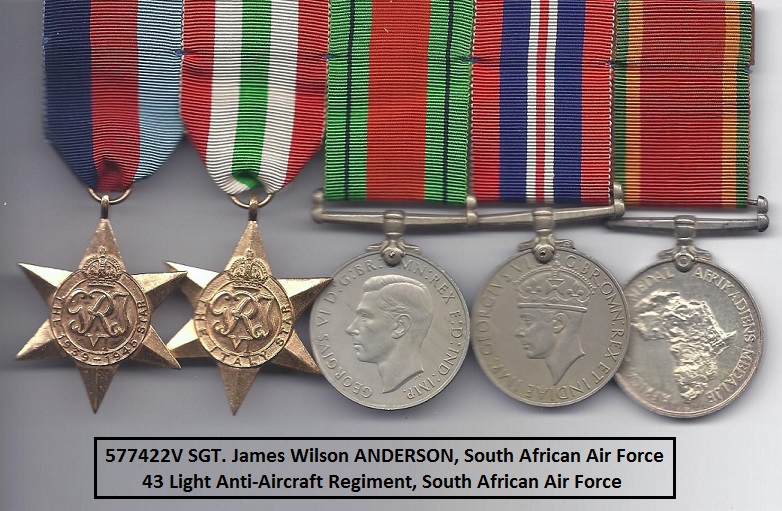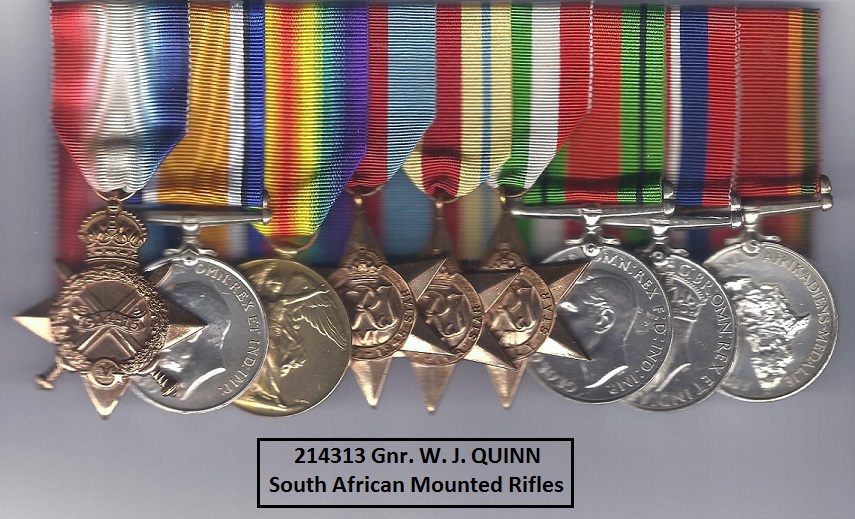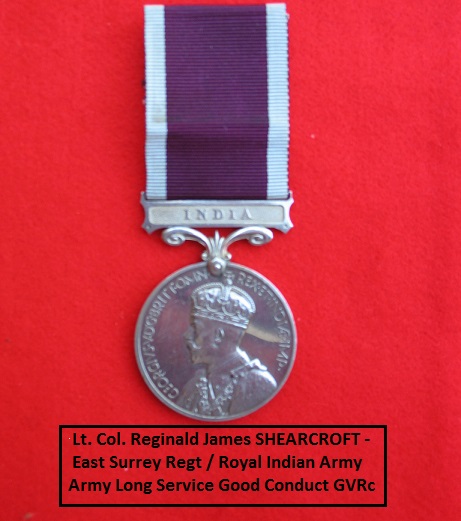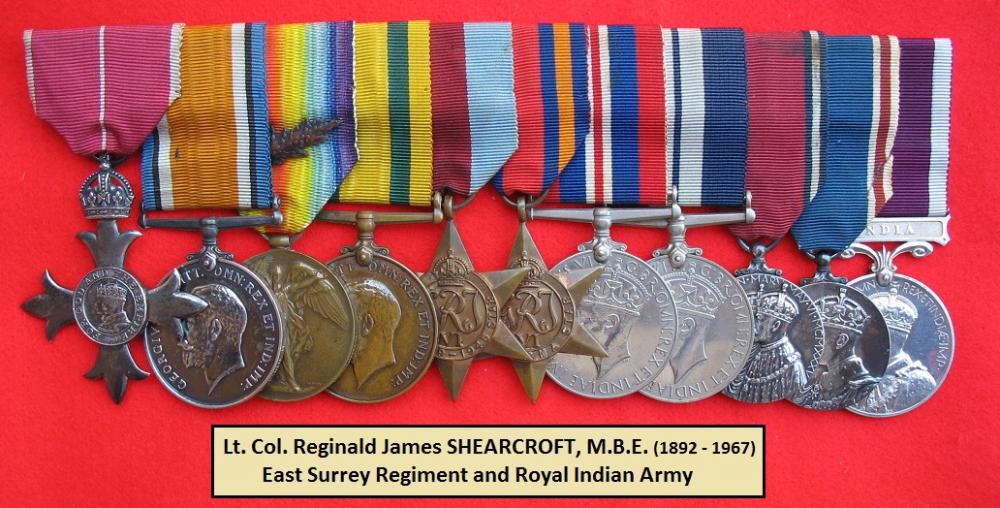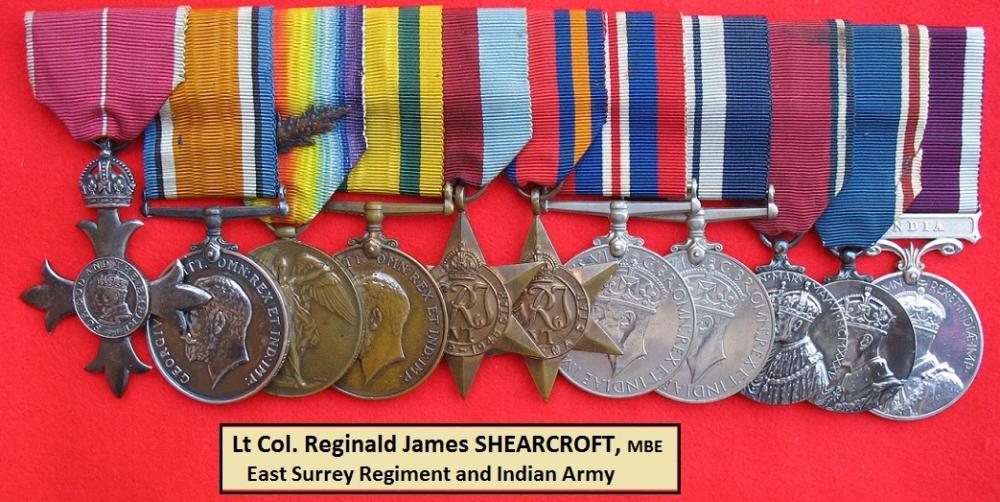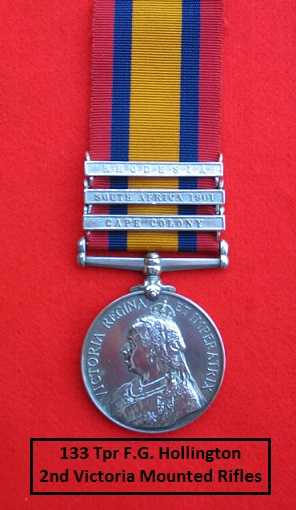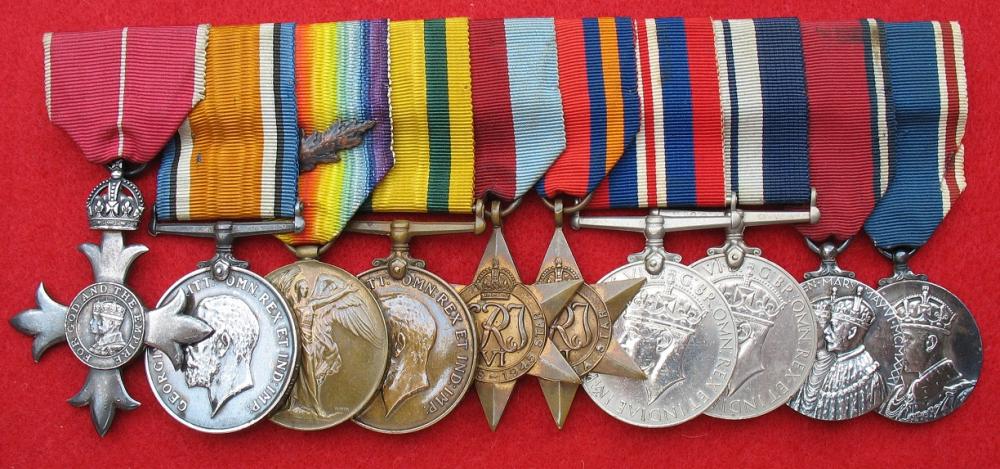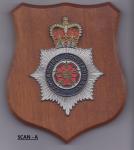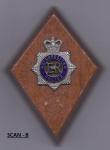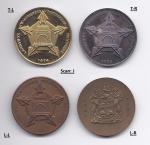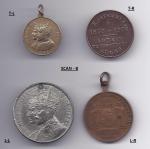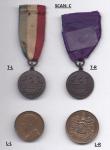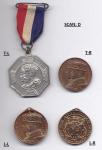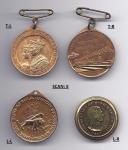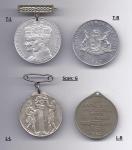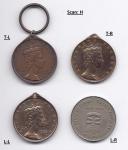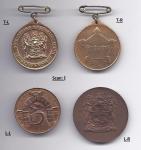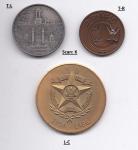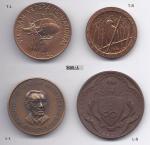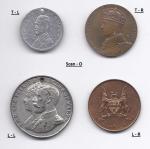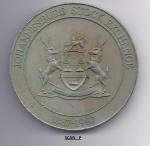-
Posts
265 -
Joined
-
Last visited
Content Type
Profiles
Forums
Blogs
Gallery
Events
Store
Everything posted by David B 1812
-
This is wonderful news, Gavin, that you are able to confirm this combination awarded to Brigadier Edwin Williamson. Thanks also for your email with a photo of the Brigadier, along with General Dan Pienaar. I assume that Brigadier Williamson is the very large man on the right hand side of the photo. Should you be able to / want to share any further details of the Brigadier with me, please Gavin, I would be most grateful to you for anything further. THANK YOU for giving me these details and confirmation ............ all the best to you.
-
Hi Gavin - This is wonderful news, indeed. Would you care to share any further information on Brigadier Williamson with me please? For example - a photo of his full - size medal group. Possibly a photo or two of the man himself. Have you done any research / or a write up on this man you would care to share, please ??? In fact I would gratefully receive ANY further details about Williamson and his group that you would care to share with me. I see that you are in Australia. Are you a former South African? Did you acquire the Group there? When? As I say, anything would be most useful for me, thank you, Gavin. If you wish to keep the matter private, then kindly email me at: david@burvest.com. Thanks SO MUCH, again, Gavin. All the best, David Bennett ===========================================================
-
C.B.E. Miniature Medal Group - WHOSE could it be ???? I recently bought the miniature medal group (illustrated here) on an auction. Of course, as a long time medal collector, I am well aware that miniature medals groups are NOT named (in the normal fashion). As this group did not come with a photo of the group with its recipient, nor was it accompanied by any documentation - so it is pretty much impossible to attribute the group to any person. OR IS IT ????? What are the facts? Well for a start, it is awarded to a South African, as the Africa Service Medal shows. Then there is the C.B.E. which is a very uncommon award to South Africans. Thirdly, he served in BOTH Wars, but after 1914-15 in the Great War, and he was M.I.D. in that War. In World War Two, he saw service in Africa, but did not go on to Italy. And, finally he has THREE Jubilee and Coronation Medals including the 1935 Jubilee, and the 1937 Coronation - which were not commonly issued to "just anyone". So he could have been a fairly senior officer during the 1930s - he may have been a long-time "career" officer ............. SO NOW - would any member of this group like to say WHO the group might have been awarded to - assuming that it is a "genuine" group - and not simply made up ............ ?????? (Here, I must immediately confess that I have NO idea). BUT I have tried to do a little bit of research to try to find out - and although it is quite easy to identify some likely South African C.B.E. recipients, it is very difficult to establish WHAT OTHER AWARDS they got.................... so this is a challenging and interesting exercise. I have managed to identify a few South African CBE recipients (who did not get other awards - eg: DSO / MC / CB / DFC. etc ) These are: Major General HG Willmott CBE Brigadier J. Daniel CBE Brigadier P. de Waal CBE Brigadier JB Kriegler CBE I have excluded Maj. Gen FRG Hoare, as apart from the CBE, he was also a CB: and also Maj Gen KR van der Spuy was excluded - he received both the CBE and an MC. I suppose that one clue to the solution would be to check the names on the three Jubilee / Coronation medal rolls to narrow down those South Africans who received ALL three, then also got a CBE and was MID in 1914 - 1918. But alas, I do not have access to those rolls. But, without knowing what other awards and medals these men received - can anyone hazard an educated guess as to who MIGHT have been awarded such a group .................. ??????? Any ideas .............. ?????? All the best, David Bennett =============================
-
LADYSMITH SIEGE MEDAL : What IS this ??? ANGLO-BOER WAR: Item of Interest - Can YOU help with DETAILS, please ??? Right - something to test you chaps: THIS is a 25mm X 25mm "Maltese / Cross Pattee" type of cross. It is roughly made, and is impressed (on one side) : "Siege of Ladysmith (and) P. of L.T.S." and on the other side: "2.11.99 / C.J.L. / 28.2.1900". NOW, either THIS cross, or one very, very similar to it was SOLD at auction by Messrs DN&W on 20.09.2002 (At the OMRS Convention); and yet another very, very similar cross (or even THIS cross) was sold at auction by Messrs GILDINGS Auctioneers, U.K. on 24.10.2017 . QUESTIONS: Has any member seen this before? Anyone have experience of this "cross". Is it unique? Or are there MANY? Who or What is the abbreviation: "P. of L.T.S." and also : "C.J.L." ??? One source claims that it is made of "gun metal" and another claims that it is made from shrapnel. I have to ASSUME that it is NOT unique, as the specimen sold by DN&W (and later by Gildings) had the SAME abbreviation: "F.C.E." (and these may be a person's initials) whilst the specimen I am showing HERE has the abbrev/initials of: "C.J.L." - which strongly suggests that there are at least TWO of these crosses ??? All comments and information would be much appreciated. Thank you.
-
UPDATE: 13 December 2017 - I have found two AUCTION prices for this rather RARE badge - see HERE - for 2016 and 2017 - All the best, David Bennett. Durban, Natal. ============================================================================================== SAAF NAVIGATOR / Bomb Aimer BADGE WORN 1937 / VERY RARE Secondhand R1,599.00 auction closed Closed 24 Jan 2017 ======================================================================= Top of Form Item: W4035 A South African Air Force -Navigator/Bomb Aimer Badge, 1937 On October 8, 2016 Auction Won For $151 = about R1960 Bottom of Form A South African Air Force; Navigator/Bomb Aimer Badge, 1937 A die struck gilt metal breast badge, issued in 1937, extremely fine. This badge was in use for a very short time, and is very scarce, with less than one hundred issued. See “Eagles Recalled”, page 214, top.
-

The Tamgha-i-Difaa, Pakistan's General Service Medal
David B 1812 replied to Brian Wolfe's topic in South Asia
-

The Tamgha-i-Difaa, Pakistan's General Service Medal
David B 1812 replied to Brian Wolfe's topic in South Asia
And HERE is something to ADD to this discussion, which I have just today discovered: A friend of mine (in Europe - who also collects these medals, amongst others) has shown me that he has one of these medals WITH AN UNOFFICIAL Clasp, which I am advised is called the "SHAQMA" clasp. And I have an illustration of it HERE. You will see that the border of the clasp is very different from the more elaborate border of the official clasp, AND that the unofficial clasp and scroll LACKS the "FIVE POINTED STAR" - or flower of the original. And finally, notice ALSO that the medal itself is similar to the SIACHEN GLACIER example we already know about - where the suspender is NOT PINNED onto the medal disc, but seems to be of a one-piece manufacture, or, at least added later by soldering (?). Any ADDITIONAL comments, fellow collectors??? And also any further information on WHY / HOW / WHEN / WHERE this new, unofficial clasp originates, please ?????? Best regards, David BENNETT. -

The Tamgha-i-Difaa, Pakistan's General Service Medal
David B 1812 replied to Brian Wolfe's topic in South Asia
Hi Brian, I collect military medals in general, and have examples from about 30 countries, but the bulk of the collection is British. Some years ago, I decided to “specialise” and now I concentrate – where my currency, the Mickey Mouse, useless, worthless S.A. Rand will permit - on the INDIA GENERAL SERVICE series, and the GENERAL SERVICE MEDAL series - and of course, local buying opportunities rarely present themselves, because, as you may know, there is a serious dearth of medal stocks available in South Africa - unlike the UK or the USA - where they are pretty much available on every street corner. And so what I am trying to accomplish, is to attempt to obtain at least ONE of each CLASP issued in these SERIES, either as singles, or in multi-clasp issues. And I have made reasonable progress, to the degree that I am now up against (mainly) expensive, or high-cost examples to complete the collection. And those medals that I DO have are mixed between British issues, and those issued to “local” or “native” recipients. I do not discriminate. Anyway, SO FAR, I have managed to accumulate the following CLASPS into my collection: INDIA GENERAL SERVICE Medal Series: 1854: Pegu; Bhootan; Jowaki 1877-8; Burma 1885-7; Hazara 1888; Burma 1887-89; Samana 1891; Hazara 1891 and, Kachin Hills 1892-93. (NINE clasps of a possible 24). 1895: Relief of Chitral 1895; Punjab Frontier 1897-98; Samana 1897 and Tirah 1897-98 (and including both a silver and a bronze example of the PF 1897-98) - (This gives FOUR of a possible 7 clasps). 1908: North West Frontier 1908; Afghanistan NWF 1919; Waziristan 1919-21; Mahsud 1919-20; Malabar 1921-22; Waziristan 1921-24; NW Frontier 1930-31; Mohmand 1933 and NW Frontier 1935. (This means TEN out of 12 possible clasps) 1936: North West Frontier 1936-37 and North West Frontier 1937-39 (TWO out of two) Then in the GENERAL SERVICE MEDAL 1918 – 1962 and 1962 - 2007 Series (Army and Air Force), I have: !918 – 1962: Iraq; Palestine; S.E. Asia 1945-46; Palestine 1945-48; Malaya (GVIR); Malaya (EIIR); Cyprus; Near East; Arabian Peninsula and Brunei. (TEN of a possible 20 clasps). 1962 – 2007: Borneo; Radfan; South Arabia; Malay Peninsula and Northern Ireland. (FIVE out of a possible 13 clasps). ====================================================================== Now, ALSO, as a sort of “supplementary” collection, because they followed the BRITISH system (more or less, after 1947-48), I am also collecting both the INDIAN and the PAKISTAN equivalent versions of the British IGS series. And, so far I have managed to acquire these: INDIA IGS 1947-1965: Jammu and Kashmir (1947-1949); Naga Hills; Goa 1961; NEFA 1962 and Mizo Hills. (FIVE of a possible seven clasps) INDIA SAINYA SEVA 1960: NEFA and Bengal-Assam (TWO of a possible six clasps) PAKISTAN GSM: Kashmir; Dir-Bajaur 1960-62; Rann of Kutch 1965; Kashmir 1964-65 and Siachen Glacier 1984. (FIVE out of FIVE clasps). I HAVE NOTICED, Brian Wolfe, that a recent acquisition of mine – the PAKISTAN GSM (or Tamgha-i-Difaa as it is also known) the MEDAL (and clasp) for the PAKISTAN GSM SIACHEN GLACIER 1984 is of a noticeably different quality / production finish to the earlier examples of the series. As you are well aware, Pakistan COPIED the BRITISH IGS and used a fancy SCROLL suspender, but instead of the British “flower” or “rosette” on the clasp, Pakistan used a five –pointed “star” or flower - but giving a similar appearance to the British issue. Using your earlier photographs of these clasps - above, I can confirm that my example of the SIACHEN GLACIER looks just like yours. That is, that the “star” on the suspender is poorly finished, and is not neatly “cut out” as in earlier medals, leaving rather thick borders around the star, and also the actual suspender appears not to be separately pinned to the medal (as should be “usual”) but seems to be formed with the disc, in a “one piece” production. These is only ONE other photograph of this medal and clasp, which I can find on “Google” and it is the SIACHEN CLASP example presently for sale by Floyd Medals (Florida, USA) HERE: http://www.floydmedals.com/order/exec/frmProductDetails.aspx?abs=1&navtypeid=MTM1&navtype=Q09VTlRSWQ==&productid=MTQwMw==&CatID=Mg==&1=1 AND you will see the same poorly formed five-pointed star and one-piece suspender/disc - the same as yours, and the same as mine, just acquired. SO, Brian, the QUESTION : It is my theory, that the earlier examples were produced in the 1950 – 1960s, whereas the SIACHEN GLACIER example could only have been produced twenty years later, in 1984 or after that date, AND that the recent medal was either produced by a different (and less skilled) manufacturer, or that less money was allocated to the medal by the authorities, resulting in what is obviously a medal and clasp of lower quality. What are YOUR thoughts on the matter? With best regards, David BENNETT. The David Bennett Collection, Durban, SOUTH AFRICA. And HERE are my three latest acquisitions, - Kashmir 1964-65 and Rann of Kutch 1965 and SIACHEN GLACIER 1984 - and I think that the comparison clearly illustrates what I have suggested in my post, above. David Bennett Durban, Natal SOUTH AFRICA -
Is DOUGLAS LIONEL BAKER the DOUGLAS LIONEL BAKER.........??????? OK - so WHO of you would like a research CHALLENGE? Is Douglas Lionel BAKER (who died on 26 April 1941) the same as Douglas Lionel BAKER (who died on 26 April 1941) ????? Puzzled ?? Yes - of course you are. And so am I. BACKGROUND: I recently bought 5 medals to "Baker" - a WWI Trio to L/Cpl Herbert Lionel BAKER - a South African who served in the 4th Infantry, then in the 3rd Mounted Rifles and finally in the S.A.S.C. (MT). And I have his full personnel file from Defence HQ in Pretoria with all his details from when he enlisted on 1.9.1914 to when he was de-mobbed on 1.4.1919. He was married to Margaret Baker. All good so far. AND with this trio came a WWII PAIR (consisting of the Defence Medal and the War Medal) as well as the Medal / Condolence Slip (shown here) and issued to a WOII D.L. Baker (for two medals), as well as two medal boxes (shown here) addressed to a Mrs H.L. Baker (the mother of Douglas Lionel Baker). The initials of "H.L." were those of her husband (and Douglas' father, Herbert Lionel) - as it was customary to address the spouse of a married couple in those days by the initials of the husband. You will see that the Bakers resided in the town of Gwelo - in Southern Rhodesia. I then did some further genealogy research and found that a Douglas Lionel Baker was born on 11 August 1916 to a Herbert Lionel and Margaret Baker. Now if you go to the CWGC website, and search Douglas Lionel Baker and the date of death, you will find ONE Douglas Lionel Baker, who died (and was buried) in KENYA on 26 April 1941. NOW THIS IS WHERE the matter starts to get a bit fuzzy, shall we say. IF you KNOW how to use the modern CWGC website, you will know that they are being very thorough, and are even allowing us to obtain COPIES of the actual DOCUMENTS filed for the deceased person, the subject of the search. The PROBLEM with the papers for Douglas Lionel Baker, is that the MAIN search shows him to be No. 6296009 Warrant Officer Class II (Company Sergeant Major) Douglas Lionel Baker of the 1st Battalion, "The Buffs" - Royal East Kent Regiment. NOW, if you examine the supporting filed papers you will find that THREE of the five papers refer to W.O.II D.L. Baker of the Royal East Kent Regt. BUT the other two papers refer to a C.S.M. Douglas Lionel Baker of the Rhodesia Regiment, attached to the 3rd Company of the 4th King's African Rifles. WHY??? WHY??? WHY???. Is this the SAME person??? (And remember that the WWII pair, and the Medal Slip (for WOII D.L. Baker) and addressed to Mrs H.L. Baker came WITH the WWI Trio to H.L. Baker - who we KNOW was the father and mother of D.L. Baker). SO: Are we talking about the SAME D.L. Baker??? Why does the CWGC refer to TWO different units in their records? We must ASSUME that D.L. Baker lived with his parents prior to WWII IN RHODESIA. Did he enlist and serve with the Rhodesia Regiment, later Attch. to the K.A.R. - and then (for whatever reason) found himself with the Buffs - and for whom he was serving when he died. (And we don't know how, or why he died - he was just 24 years old). IS Douglas Lionel BAKER the Douglas Lionel BAKER??? And WHY is he?? Or not? There is a little something for you guys to get your head around.......................... Comments and opinions most welcome. One possible suggestion (from a collecting friend) was that it IS the same Douglas Lionel Baker, and that upon his death, BOTH Regiments he served with submitted their papers to the CWGC. (From the David Bennett Collection)
-
Dear Paul Wood - Shearcroft ended WWI as a Sergeant. His Medal Index Card shows him having THREE NUMBERS: 5776 On the TFWAR Medal (The Queen's) and, 240050 for the East Surrey Regiment and, L/14214 for the Queen's Regiment. Shearcroft has MANY entries (I have them all) in either the IML and/or the LG in these years: 1928;1935;1936;1939;1941;1942;1949;1968. The ONE entry which I DO NOT have (or rather, I cannot find in the damn LG) is for the M.I.D. (And, as he is wearing the MID emblem on his VM, then we must presume that the MID was during the Great War ............) If you have ANY ideas of where I might find a PHOTO of Shearcroft, I would appreciate that very much. Thank you. All the best to you, and thank you to the earlier members for their kind comments. David Bennett In the Last Outpost of the British Empire.
-
I collect (mainly) MILITARY MEDALS - specialising in trying to assemble a collection of every issued Clasp of the India General Service Medal Series (1854; 1895; 1908; 1936) and one of every Clasp issued of the Army General Service Medal (1918 and 1962). So far I have just 39 of these Clasps - so a long (and expensive) way to go....... I have been a serious Collector of Military Medals since 1980. But being a medal collector in general, and a South African - it is only natural that I should have a fair selection of South African medals and groups, too. I obviously have some South African WWI trios and pairs. Similarly, I have a good representative sample of South African WWII Groups. NOTE WELL: In the discussion which follows, we will IGNORE any medal groups which contain Gallantry, Long Service and similar medals in the groups. So, in WWI the VAST MAJORITY of South African soldiers were awarded either the WWI Trio, or, at least a WWI Pair. And, in WWII MOST South Africans earned, probably, FOUR, FIVE or SIX medals - this would depend on HOW LONG you served "up north" and whether you went to Italy or not. SO, the most common South African WWII Groups are: FOUR: 1939-45 Star; Africa Star; 1939-45 War Medal; Africa Service Medal FOUR: 1939-45 Star; Italy Star; 1939-45 War Medal; Africa Service Medal FIVE: 1939-45 Star; Africa Star; Italy Star; 1939-45 War Medal; Africa Service Medal, and, SIX: 1939-45 Star; Africa Star; Italy Star; 1939-45 Defence Medal; 1939-45 War Medal; Africa Service Medal And I KNOW that there are variations of these - where just two or three medals were awarded, but in my experience, THESE are the four MOST common groups to South Africans. Also when one considers that South Africans earned over 60,500 Italy Stars, and more than 105,000 Africa Stars then the 7,200 or so OTHER STARS (excluding of course the 1939-1945 Star) awarded to South Africans do not merit discussion here. And I am also excluding things like the "8th Army" and the North Africa 1942-43" Clasps, as well. And, we are also not including in this discussion the possibility of Anglo-Boer War / Zulu Rebellion / and Korean War medals as well. Such groups are VERY scarce......... Now, if you will agree with me, based on the criteria I have defined above, then it IS, and WAS most certainly POSSBLE for a South African soldier, under the "RIGHT" conditions, and IF he served in BOTH WARS, to earn what I call a "FULL HOUSE" - THAT IS the WWI "TRIO" and all SIX of the WWII MEDALS. But in reality, how easy was this? To qualify for what I call the South African "FULL HOUSE" for the two World Wars, would mean a group of NINE medals - excluding gallantry, long service, coronation / jubilee medals, etc. So I checked my collection. I have South African WWI pairs and trios. Some WWI groups which include a couple (or more) WWII medals, but until a recent auction acquisition by me, NO S.A. GROUPS which give us the NINE MEDAL "FULL HOUSE" - the best I had were some five, six, seven and even eight medal groups. BUT NOW, AT LAST, a NINE MEDAL "FULL HOUSE" Group in my collection. So as a result, please show us (with names / details) YOUR "Full House" WWI / WWII groups in your collection - excluding, as I say, gallantry, long service, etc etc. This would be an interesting exercise. And I would say that - when compared to your full collection - the number of "full house" groups is probably quite small................... ??? I have ILLUSTRATED a few groups from my own collection ("The David Bennett Collection") including the new "FULL HOUSE" group - merely to show some representative examples of what I am talking about. Thank you for reading this. All the best, David Bennett Durban North ============================================== There are three groups illustrated below, without details: The first (with a North Africa 1942-43 Clasp) is to Sgt H.J. Whitebooi, 24 Bomber Sqdn, S.A.A.F. The next group (of five medals) is to F/Sgt E.F. Williamson, S.A.A.F. and, The third group (with the 8th Army Clasp) is to Gnr. H.F.P. Combrink, S.A. Artillery. (I have yet to "lable" these 3 groups.) By the way, the group to COMBRINK is interesting, because his parents named him after the THREE LEADING WWI ALLIED MILITARY LEADERS: So his name is HAIG FOCH PERSHING Combrink ............ not something you see everyday !!!!!!!
-
Collecting Police Truncheons / batons is not a specialist collecting area for me. However, recently, whilst I was on a visit to a Cape Town boot sale market, I saw (and bought) the S.A. Police truncheon shown below. Although I cannot say for certain, some people I have consulted think that the widespread USE of this MODEL of Truncheon / baton by the S.A.P. ended "around 1985 - 1986" (but I think that those are, at best, just guesses.) Is there a MEMBER of this GROUP, who can please tell me, with some authority: (A) The PERIOD during which this Truncheon was IN USE by the South African Police. (and I mean THIS specific model) That is, the DATE that use of this MODEL STARTED, and the DATE when use of this model ceased and it was withdrawn from use. (B) Does this MODEL have a specific NAME / TYPE / MODEL Number ??? ..................... and, (C) What are the TECHNICAL DIFFERENCES / DEFINITIONS between: (i) A Truncheon, and (ii) A Baton. Thank you very much, David Bennett, Durban North ==============================
-
I have previously written on this GMIC FORUM about my medal group to Lt. Col. Reginald James SHEARCROFT, MBE. (East Surrey Regiment and Royal Indian Army) In 1987 I bought a TEN medal group to Lt Col Shearcroft. It is illustrated elsewhere on this site. Apart from the award of the MBE (and the MID) notable is the presence of the 1914-19 Territorial Force War Medal, and later, for WWII - the Burma Star and the India Service Medal - obviously for service in the INDIAN army. Records show us that Lt Col Shearcroft served in the Army for 36 years, BUT THERE IS NO MEDAL PRESENT WHICH rewards him for his service. Not an Army LS&GC medal nor an Efficiency Medal nor anything similar. BUT SURELY he should have got something? Yes, of course. After all, the man progressed through the ranks from Private to Sergeant to Major to Lt. Colonel. 36 years. BUT WHERE IS IT???? I have asked this question in many Groups (including this one) and the most usual (and at the time, probably correct) answer was that Shearcroft likely DID earn a LS&GC whilst in the ranks, but that once he became an Officer, decided NOT to wear it - so that his fellow officers could not easily see that he had spent many years in the ranks.................. BUT THE MISSING MEDAL WAS NOT / IS NOT present with the Group........ AND THEN, earlier this year (2016), after owning Shearcroft's group for nearly thirty years I FOUND IT !!!!!!.. Whilst doing some research I discovered that Shearcroft's Army LS&GC medal (INDIA issue, no less) had been auctioned by Dix Noonan & Webb to a collector in England in 2012 - and the collector, in turn, had bought it as an Army LS&GC TYPE example. Anyway, about four months or so back, following exchanges of correspondence between myself, DNW and the gentleman concerned, it was agreed to sell the "missing" LS&GC medal to me. This was done and NOW I HAVE IT.....!!!!! I am of course, extremely pleased to have completed this important RE-UNITE after nearly THIRTY YEARS. The medal itself is an Army Long Service and Good Conduct Medal, Third Type (1930-1936), GVR (C), Commonwealth bar - INDIA. I have also discovered (since I last wrote on the subject) that after Shearcroft left the Army, after the War, he emigrated, with his wife, first to South Africa (Port Elizabeth) and then later to Rhodesia, where he died in Salisbury in 1967. This would explain how I was able to buy his medals from an S.A. Dealer in 1987. I have done a huge amount of research on Shearcroft, and have ALL the LG entries for his M.B.E. award; his promotions; his various Army appointments, etc etc. There is just ONE MATTER not yet COMPLETE - that is the LG entry for the M.I.D. apparently awarded to Shearcroft. I have found the L.G. website VERY DIFFICULT (and impossible, at times) to use and search, and if there is ANY KIND SOUL out there with more patience than myself, it would be much appreciated if Shearcroft's MID entry could be found, please. And, of course, as you can imagine, the FIRST PRIZE, GOLD MEDAL, PINNACLE of everything would be to find a PHOTOGRAPH of Shearcroft. Anyone ??????? Thanks for reading this. All the best, David BENNETT - Durban North.
-

British Raj Lt. Col
David B 1812 replied to David B 1812's topic in Great Britain: Research, Documentation & History
MEDAL - Re-United with MAIN GROUP........................ AT LAST,............................ !!!!!!! Finally I have acquired from the previous owner the ARMY LS&GC medal (INDIA) which was missing from Lt. Col. Shearcroft's impressive group. So the COMPLETE group, now looks like THIS: -
ANGLO-BOER WAR - 1899-1902 : AUSTRALIAN troops. Are there any EXPERTS on the involvement of Australian Troops in the War on this Group? I have a Q.S.A. with the Clasps for Cape Colony; Rhodesia and South Africa 1901. The three clasps are CONFIRMED on the Roll WO100/291 (at pages 74 and 105). BUT HERE IS THE QUESTION: The Roll is for the 4th Victorian Imperial Bushmen (on whose roll appears the man as: # 133 Pte Francis George HOLLINGTON) HOWEVER, the actual MEDAL is named to: 133 Tpr F.G. Hollington, 2 VMR. i.e. to the 2nd Victoria Mounted Rifles. QUESTION: Why is this????? I did write to the National Archives of Australia, who advised that the FOURTH Victorian Contingent consisted of Five companies of Mounted Rifles. In the Australian Archives "Boer War Index" is listed: Hollington, F.G. Vic. 4 (Imperial) CNTGNT. And also it mentions that Hollington appears in Lt Col Murray's book at 263. My further research shows that the 4th Imperial Bushmen left South Africa (East London) aboard the "Orient" on 22 June 1901 - arriving at Melbourne on 12th July 1901. BUT (an important BUT) - A fellow researcher (Kerry Bulow) advised me THAT: "Hollington was born on 29/10/1874. He was 5ft 7in. His next of kin was his mother, Mrs Jenny E. Hollington from East Dene, Hermon Hill, Wanstead, Essex, England. When he enlisted, he stated that he was a farmer. Address: 1A Evalina Road, Toorak, Victoria. Bulow confirms the Murray entry that Hollington went BACK to England and was discharged there on 9 August 1901. So, WHAT did / or what WAS Hollington doing between when the 4VIB left S.A. in June 1901, and when he arrived in England in August 1901. COULD THIS EXPLAIN the anomaly between Hollington being on the 4 VIB Roll, but his medal named to the 2 V.M.R. ????? What theories do you chaps have???? (Medal from the David Bennett Collection).
- 1 reply
-
1
-

British Raj Lt. Col
David B 1812 replied to David B 1812's topic in Great Britain: Research, Documentation & History
Thank you, guys, for your recent comments and additional information. A GOLD STAR and 10/10 to any man (or lady) who can produce a PHOTO of Lt. Colonel Reginald James Shearcroft, MBE....................... !!!!!!!!!! :-) -

British Raj Lt. Col
David B 1812 replied to David B 1812's topic in Great Britain: Research, Documentation & History
I have just discovered, through some diligent research, that SHEARCROFT did in fact qualify for, and receive an Army Long Service and Good Conduct Medal (Indian) type GVR 3rd Issue. It was auctioned by Dix Noonan Webb - Lot 621 - of their auction of 28-29 March 2012. How or why this LS&GC Medal came to be separated from Lt Col Shearcroft's main group (of ten medals) I do not know. The main group is in my collection. I am following up with DNW to try to contact the buyer - in the hope of a re-unite. I can also add that Shearcroft left the Indian Army in 1948. He emigrated, with his wife, to South Africa in 1949 and died in Salisbury, Rhodesia on 8 September 1967. I have owned this medal group since I bought it in Johannesburg in 1987 from Messrs P&G Coin Co. (for R533 !!!!!! - can you believe it..... ???). Anyway, EVEN THOUGH I have owned the group for these past 28 years - and have often admired it as one of my largest groups, it was just yesterday pointed out to me by a very sharp fellow collector that the RIBBON for Shearcroft's 1939-1945 India Service Medal is NOT the India Service Medal ribbon, but is in fact the ribbon of the Distinguished Service Medal ..... !!!!!!!!!!!!! This is very odd and most curious...... A possible answer is that the military tailor who mounted the group confused the two ribbon types (they are in fact VERY similar) ...... OR had he run OUT of the correct ribbon, using the DSM as a "replacement" ? We may never know the answer...................???? -
Here are three Police Badges / Shields I would be obliged to get proper identification, please. i.e. Proper name, badge / shield type, period in use, etc And any other pertinent details, please. They are: Scan - A: Lancashire Police. 12cm x 9cm appears to be plastic Scan -B: Metropolitan Police. 5cm x 4cm. Enamelled metal. Scan - C: Metropolitan Police. 12cm x 9cm. Metal. Steel, possibly. Thank you, David B ==============================================
-
David R. BENNETT – The DAVID BENNETT MEDAL COLLECTION© A Collection of Non-Official Military, Military Related, Commemorative and Other Sundry Medals and Medallions – 2014 © This is an illustrated study / analysis of my own collection, covering about 55 medals and medallions which, although most are ‘non-military’ (some HAVE a military connection, although they are ‘non-official’), they may have interest for collectors of military medals. When we acquire groups of military medals, they quite often come with sundry badges, photographs, papers, etc., and, sometimes, assorted medals or medallions such as those listed here. Essentially, I have created what might be considered a ‘basic reference collection’ on this subject, to which other collectors / members may wish to add, thus building up a nice reference list. Not all these medallions or medals have a South African connection. Some relate to the U.S.A.; Germany; the U.K.; Rhodesia; Israel, Vietnam and Italy. NOTE: With reference to the ILLUSTRATIONS, below: T-L = Top Left; T-R = Top Right; L-L = Lower Left and obviously, L-R = Lower Right, unless otherwise stated. Reference to ‘Rosignoli’ is the book: “Ribbons of Orders, Decorations and Medals” by Guido Rosignoli, 1979, Blandford Press, Poole, Dorset, U.K. Any Internet addresses given were correct at the time of writing this article, July, 2014. =========================================================================== Scan A: T-L: 1887: Queen Victoria Jubilee (Leeds version), white metal, 38mm. Obv: “Victoria Born 1819 Ascended the Throne 1937”. Rev: “Commemoration of Queen Victoria’s Jubilee, 1887”, with Arms of the City of Leeds. A copy of this medal is held in the Leeds City Museum. T-R: 1887: Queen Victoria Jubilee, bronze, 38mm. (Issuer unknown.) Obv: “Victoria Reg - Jubilee Year 1887”. Victoria portrait by Heaton. Rev: (upper) Crown surrounded by rays. (lower) left and right – wreath. With the inscription: “In Commemoration of the Fiftieth Year of the Reign of H.G.M. Queen Victoria. Ascended the Throne June 20th 1837”. L-L: 1887: Queen Victoria Jubilee, white metal, 32mm. (Issuer unknown.) Obv:”In Commemoration of the Jubilee Reign of H.G.M. Queen Victoria 1837 – 1887”. Rev: (upper) Crown surrounded by rays. (lower) left and right – wreath. With the inscription: “Victoria E.I. Born May 24 1819; Ascended June 20.38; Crowned June 28.38; Married Feb.10.40; Jubilee 1887”. L-R: 1900: Lord Roberts, bronze, 30mm (Society of Miniature Rifle Clubs) Obv; (portrait of Lord Roberts) Legend: “Field Marshal Lord Roberts of Kandahar” Rev: Seated Winged Victory, pointing to centre of Rifle Target. Legend: “Society of Miniature Rifle Clubs”. (see: http://www.rifleman.org.uk/Society_of_Miniature_Rifle_Clubs.htm ) ========================================================================= Scan B: T-L: 1901: King Edward VII, bronze, 24mm (issuer unknown) Obv: “King Edward VII and Alexandra – 1901” Rev: (uncrowned portrait of Edward and Alexandra) Legend: “Prince and Princess of Wales, Nov. 9th 1901”. T-R: 1908: Kaffraria, copper, 30mm (issuer unknown) (German Immigrants) Obv: “Kaffraria. 1858 – 1908. Arbeit Ueberwindt Alles”. Rev: “Zur Erinnerrung An Die 50 Jaehrige Feier Der Landung Deutscher Ansiedler in Sued Afrika”. Commemorating the arrival of 1600 German settlers in the N.E. Cape, in 1858. L-L: 1911: King George V, white metal, 38mm (issuer unknown) Obv: “H.M. King George V and Queen Mary”. Both crowned portrait. Rev: Britannia standing, at left. Above - Royal Arms. Lower – Empire Arms. Legend: “Coronation June 1911. God Save the King”. L-R: 1919: City of Johannesburg – Peace Medal, copper, 32mm Obv: Soldier (L) Sailor ® either side of what appears to be a Miner. Legend: “To Commemorate The Conclusion of the Great War. Peace with Honour”. “1914 – 1919”, and “Reg 14/1919”. Rev: Johannesburg City Arms, surrounded by laurel wreath. “28th June, 1919. Johannesburg”. ========================================================================= Scan C: T-L: 1914 – 1918: Durban Recruiting Committee Medal, (City of Durban), bronze, 26mm Obv: (upper) Springbok Head, surrounded by a Laurel Wreath, with central inscription: “PRO PATRIA”. Medal suspended from a Blue, White and Red Ribbon (possibly original). Rev: (on plain field) “Presented by the Durban Recruiting Committee” T-R: 1914 – 1918: Durban Recruiting Committee Medal, (City of Durban), bronze, 26mm Obv: (upper) Springbok Head, surrounded by a Laurel Wreath, with central inscription: “PRO PATRIA”. Medal suspended from a Violet Silk Ribbon (possibly indicating mourning). Rev: (on plain field) “Presented by the Durban Recruiting Committee” L-L: 1925: Edward Prince of Wales, bronze, 28mm (South African – Pretoria Mint) Obv: Uncrowned left facing portrait of Edward, with the legend: “Edward Prince of Wales”. Rev: A fasces surrounded by a Protea Wreath, with the legend: “S.Africa, Z. Afrika 1925”. Probably to commemorate the Royal Visit of the Prince of Wales to South Africa in 1925. A copy of this medallion is in the Royal Collection Trust. (A similar medal, was also issued by the Province of Natal – with the Natal Coat-of-Arms reverse, as well as another six other local variations). L-R: 1934: Prince George Visit to Durban, bronze, 30mm. City of Durban. Obv: The full Coat-of- Arms of the City of Durban (for the period). Rev: On a plain field, the legend: “To Commemorate the Visit of H.R.H. Prince George to Durban March 1934”. ======================================================================== Scan D: T-L: 1935: King George V Jubilee, Middlesex, silvered base metal, hexagonal, 38mm x 38mm Obv: Crowned profiles of King George V and Queen Mary, bearing the inscription: “King George. Queen Mary. Silver Jubilee. A.D. 1935”. Rev: Coat of Arms surrounded by a Laurel Wreath, inscription: “County of Middlesex”. Presented by the County Council. With what is thought to be the original, pinned, ribbon. T-R: 1935: King George V Jubilee, South Africa, bronze, 32mm (NOT suspended) Obv: Crowned, robed profiles of King George V and Queen Mary, with the legend inscribed as: “VI . MAII . MCMX . MCMXXXV” Rev: The Coat of Arms of the Union of South Africa (of the period), with the legend: “Unie Van Suid Afrika – Union of South Africa”. (S.A. Mint) L-L: 1935: King George V Jubilee, South Africa, bronze, 32mm (WITH Suspension hole) Obv: Crowned, robed profiles of King George V and Queen Mary, with the legend inscribed as: “VI . MAII . MCMX . MCMXXXV” Rev: The Coat of Arms of the Union of South Africa (of the period), with the legend: “Unie Van Suid Afrika – Union of South Africa”. (S.A. Mint) L-R: 1935: King George V Jubilee, South Africa, bronze, 32mm (WITH Suspension hole) As T-R and L-L above, but showing the REVERSE of the medallion. (S.A. Mint) ======================================================================== Scan E: T-L: 1936: Empire Exhibition Johannesburg, bronze, 32mm (S.A. Mint) Obv: Exhibition Hall, with the legends: “Empire Exhibition – Rykstentoonstelling – Ex Unitate Vires” Rev: In-spanned Ox-wagon, with setting sun behind. Legend: “Johannesburg 1886 - Eendragt Maakt Magt” (Unity is Strength) T-R: King George VI Coronation 1937, South Africa, bronze, 32mm (S.A. Mint) Obv: Portrait King George VI and Queen Elizabeth - robed and crowned. With the legend: “Kroning – Coronation – 12.5.1937” Rev: A Lion and Lioness, with Sun behind. Legend: “Unie Van Suid Afrika – Union of South Africa”. L-R: King George VI Coronation 1937, South Africa, copper, 32mm (S.A. Mint) As T-R above, but showing the REVERSE of the medal. L-L: King Edward VIII Coronation 1937, copper and brass (plated ?) 30mm (issuer unknown) Obv: Portrait, uncrowned, Edward VIII, right facing, in uniform. With the Legend: “Coronation of King Edward VIII – 1937” Rev: This medallion has no reverse – fitted with a “button-hole” clasp. NOTE: This is a very interesting medallion, because Edward was NOT crowned, and, by 10 December, 1936, he had abdicated and the 1937 ‘crowning’ date was used for George VI instead. ======================================================================= Scan F: T-L: Allied 5th Army - Liberation of Naples, 1943, brass, 30mm – Medallion TYPE IV Obv: Mount Vesuvius and Naples Bay, (without boats) with inscription: “5th Army” Rev: “Commemorative Medal – Of the Entrance of the Allied Armies in Naples – 1st October 1943”. (Script is partially curved around the medal, and straight in the centre) This medallion is suspended from a plain orange ribbon. T-R: Allied 5th Army - Liberation of Naples, 1943, brass, 30mm – Medallion TYPE V Obv: Mount Vesuvius and Naples Bay, (with boats) with inscription: “5th Army” Rev: “Commemorative Medal – Of the Entrance of the Allied Armies in Naples – 1st October 1943”. (Script is in a series of straight lines on the reverse of this type) This medal is suspended from an Italian medal ribbon (cf. Rosignoli - No.143) using the ribbon of the medal: “Commemorative dell’ Asse” – the Italian/German Alliance Medal. Note: This medal exists in seven similar TYPES, I to VII and I have, through an internet search, seen at least NINE different ribbons used. For a study of the seven different types, please see: http://www.questmasters.us/Italian_Campaign_Memorabilia.html Rosignoli illustrates this medal with the Italian Fascist March on Rome Medal ribbon (No. 64) suggesting that at the time, various different Italian medal ribbons were used, by the local Italian manufacturers of the Medal, in Naples – i.e. whatever was available, locally. L-L: Peace Medal, 1946, aluminium (?), 32mm (issuer unknown) Obv: Portrait King George VI and Queen Elizabeth - robed and crowned. With the legend: “H.M. King George VI - H.M. Queen Elizabeth”. Rev: Flying Angel, two Laurel Wreaths, inscribed: “Peace Declared – June 1946” L-R: Royal Visit, South Africa 1947, copper (?) 32mm – probably Government issue. Obv: Portrait King George VI and Queen Elizabeth - robed and crowned. Inscribed around outside: "Royal Visit - Koninglike Besoek". Rev: The Coat of Arms of the Union of S.A., of the period, with” 1947” underneath. Inscribed around the outside: “Unie Van Suid-Afrika - Union of South Africa” ========================================================================== Scan G: T-L: Royal Visit, South Africa 1947, aluminium (?) 34mm – probably Government issue. Obv: Portrait King George VI and Queen Elizabeth - robed and crowned. With the legend: “George VI – Elizabeth - South Africa 1947”. Suspended from a pin bar with Laurel Wreath. Rev: South Africa Coat of Arms, of the period, with the legend inscribed around this: “Commemorative of Royal Visit – 1947” T-R: Royal Visit, South Africa 1947 Showing the REVERSE of T-L, above. (without suspender) L-L: Jan Van Riebeeck, Tercentenary 1952, cupro-nickel, 32mm (issuer unknown) Obv: Small bust of Jan Van Riebeeck upon a fluted pedestal, flanked by a young girl (left) holding a palm-frond; and a young boy (right) placing a Laurel Wreath on the head of Van Riebeeck. No inscription. Rev: Plain field with the inscription in horizontal lines: “Jan Van Riebeeck – Drie Honderd Jarige Gedenkdag – Tercentenary – 6 April 1952” L-R Jan Van Riebeeck, Tercentenary 1952 Showing the Reverse of L-L above (w/o suspender) ========================================================================= Scan H: T-L: Queen Elizabeth II Coronation 1953, Port Shepstone, bronze, 32mm Obv: Right facing portrait of a crowned Queen Elizabeth II with the date “2.6 and 1953” either lower side of the portrait, and inscribed around the outside: “Elizabeth Secunda” Rev: In the centre, a three-mast sailing ship, in full sail (possibly the Coat-of-Arms) and the words: “Borough of Port Shepstone” inscribed around the ship. On the outer edge of the medal reads the inscription in large capitals: “CORONATION – KRONING” T-R: Queen Elizabeth II Coronation 1953, bronze, 32mm (issuer unknown, possibly Govt.) Obv: Right facing portrait of a crowned Queen Elizabeth II, but WITHOUT date, and inscribed around the outside: “Elizabeth Secunda” Rev: Around the outside, two elaborate Laurel Wreaths in a circle. In the centre, two proteas with the date, “2.6.53” between them, and around those, the larger inscription: “CORONATION – KRONING” L-L: Queen Elizabeth II Coronation 1953, Bulawayo (Rhodesia), bronze, 32mm Obv: Right facing portrait of a crowned Queen Elizabeth II with the date “2.6 and 1953” either lower side of the portrait, and inscribed around the outside: “Elizabeth Secunda” Rev: In the centre, the Coat-of-Arms of the City of Bulawayo (Rhodesia) with the inscription: “CORONATION” immediately below the Arms. Around the outside: “Presented by Bulawayo”. L-R: The State of Israel 1973 – 25th Anniversary, cupro-nickel (?), 32mm Obv: In the centre, a Menorha, with “25” below, and the dates “1948 – 1973” below that. Inscribed around, the legend: “Twenty Fifth Anniversary of the State of Israel”. Rev: On a plain field, showing a Star of David above and below, between which is inscribed in seven lines: The first two lines in Hebrew script; the next two: “Presented By The S.A. Zionist Federation”, and the last three lines: “Geskenk Deur Die S.A. Sionistiese Vereeniging”. =========================================================================== Scan I: T-L: Republic of South Africa 1961. Establishment of the Republic, bronze (?) 32mm Obv: The 1961 Coat-of-Arms of South Africa, surrounded by the words: “Republiek Suid-Afrika”, and “Republic South Africa” Rev: A stylised line plan of the five pointed Cape Town Castle, with the date “31-5-1961” in the centre. T-R: Republic of South Africa 1961. Establishment of the Republic, bronze (?) 32mm Showing here, the REVERSE of T-L, above. L-L: Republic of South Africa, 1966 5th Anniversary, bronze (?) 32mm Obv: A stone arch, with a Springbok head at the keystone position, and a large figure ‘5’ in the Arch. To either side of the arch, the words: “Republik van Suid-Afrika” and “Republic of South Africa” Rev: The Coat-of-Arms of the City of Johannesburg, with the word: “Johannesburg” on the lower edge, below the Arms. Otherwise plain. The reverse of this medal is illustrated in Scan – O at L – R. L-R: Republic of South Africa, 1971, 10th Anniversary, bronze, 38mm (S.A. Mint, Proof) Obv: The S.A. Coat-of-Arms, with ‘1961’ and ‘1971’ on either side. Rev: A stylised running figure in a large crashing wave, with the words: “Groei – Growth”. ========================================================================= Scan J: T-L: ) South Africa 1974, 25th Anniversary, Voortrekker Monument, Gold, Silver, Bronze, 38mm T-R: ) Issued by the South African Mint. A numbered (this # 61) three Medallion set, in 9ct gold, T-L: ) solid silver and bronze. The Obverse shows a stylised Cape Town Castle, with the Voortrekker Monument (situated on a hill, south of Pretoria) in the centre, and “1974” below. Around the edge, the inscription: “Landswye Kwaarteeufees Voortrekker Monument” in Afrikaans (in English: National Quarter Century Anniversary, (of the) Voortrekker Monument). The Obverse of all three medallions is shown. Reverse: An elaborate wreath of protea flowers and leaves around the outside, with the inscription in straight lines, in the centre: “1949 – Quo Vadis? – 1974 – Ons Antwoord”. (In English, “We Answer”). All contained in a velvet-lined, recessed, S.A. Mint red leatherette case. T-R: South Africa, 1981, 20th Anniversary, Republic, Bronze, 38mm, S.A. Mint, cased. Obv: On an otherwise plain field, a large stylised flaming torch. Rev: The S.A. Coat-of-Arms and, on either side, the dates: “1961” and “1981”. The ILLUSTRATION (Scan J) shows the Reverse of the medallion. ======================================================================= Scan K: T-L: South Africa, The Castle, Cape Town Undated, metal composition unknown, 38mm Obv: A view of the front entrance of the Castle, Cape Town, with below the Main Gate, the inscription: “The Castle – Die Kasteel”. Rev: a completely plain field. This is very likely a tourist memento of the Castle. (c.1998) (South African Historical Mint) T-R: Vryheid, Natal, South Africa, 1984 Centenary, bronze (?), 32mm (S.A. Mint, cased) Obv: On the right, the Coat-of-Arms of the town of Vryheid, in Natal, with the word “VRYHEID” at the top. In the centre portion: “Eeufees – Centenary” and below, the date: “1984” Rev: On an otherwise plain field, the Coat-of-Arms of the town of Vryheid. L-C: The Institute of Traffic Officers, South Africa, 1986, (composition unknown), 51mm Obv: The Coat-of-Arms of the S.A. Institute of Traffic Officers, dominated by a five-point star. Inscriptions – At the top the figure “50” – for the 50th Anniversary of the Institute. “I.T.O – I.V.B.” on either side of the vertical arm of the Star. Around the lower arms, the legend: “Tutela – 1986 – Officium” and, around the lower edge: “1936 – 1986”. Rev: On an otherwise large, plain field, two Laurel Wreaths, forming almost a circle, allowing, in the plain area, for engraving details of a recipient / presentation. =========================================================================== Scan L: T-L: U.S.A. The Vietnam Veterans National Medal 1984, bronze, 38mm Obv: U.S. Combat Troops engaged in a Helicopter Assault, superimposed over a map of Vietnam. Around the outer border, the words: “Vietnam Veterans National Medal” Rev: An eagle, two American flags, and the Capitol building in the lower central quarter. Above that, on a plain field, and in straight lines, the legend: “In honor of those men and women who gave of themselves in an effort to ensure democracy and peace throughout the world this medal is struck. By Act of Congress 1984”. T-R: U.S.A. The Vietnam P.O.W. / M.I.A. Medal. 1983, bronze, 34mm Obv: An eagle, partially concealed in a bamboo grove – representing Americans in captivity. Inscribed around the edge: “POW – MIA – Missing while serving in the defense of freedom in Southeast Asia”. Rev: An engraving of the Vietnam Service Medal in the centre, with the words: “You Are Not Forgotten” above, and below: “By Act of Congess, September 1983”. Around the outer edge of the obverse, is inscribed: “Honoring Americans Still Missing”, and, “1961 – Vietnam – Laos – Cambodia – 1973”. The medal comes in two TYPES: (a) As a medal, that is, with a small, plain ring suspension, using the standard U.S.A. green, yellow and red Vietnam Service Medal ribbon. The second type is: (b) As this example, - an un-suspended medallion. Type (a) is NOT authorised for wear. L-L: South Africa. The GILL MEMORIAL MEDAL, 1960, bronze, 38mm Obv: A portrait of Edward Leonard Gill (1877 – 1956) an eminent South African Ornithologist. Inscription around the edge: “Gill Memorial Medal – South African Ornithological Society” Rev: On a plain field, on the upper half, allowing the lower half to be engraved with the details of the recipient, the words: “For Services to Ornithology South of the Zambezi” (‘South’ of the Zambezi River is considered, for Birding purposes, to be ‘South Africa’) The Medal was instituted by the S.A.O.S. in 1960, and first awarded in that year. The award of this medal is VERY RARE, and between 1960 and 1998 (38 years) the medal was only awarded 14 times. There have been a further seven awards between 2008 and 2014. THIS MEDAL, only the fifth to be awarded, in 1972, was to Phillip Alexander Clancey, DSc (26 September 1917 – 18 July 2001) who was a leading authority on the ornithology of South Africa, and bird artist. Dr. Clancey was Director of the Durban Natural Science Museum from 1 January 1952 until his retirement on 25 September 1982. The OBVERSE of the medal is thus inscribed: “P.A. Clancey – 1972” The medal was made by the S.A. Mint, and is cased in their usual style. This MEDAL forms part of the David Bennett Medal Collection, along with the military medals of Dr. Clancey: 913613 Gunner P.A. Clancey, Royal Artillery: 1939-45 Star; Italy Star; 1939-45 Defence Medal; 1939-45 War Medal; Efficiency Medal, Territorial (GviR, t.B), and the Coronation Medal, 1953,(EIIR). L-R: U.K.- Manchester University, Sports Medal, 1913, bronze, 44mm Obv: An elaborate depiction of the Manchester University Coat-of-Arms, amongst various other decorative devices and borders. Rev: Around the edge, the words “Manchester University Athletic Sports”. Inside that, a circular laurel wreath, leaving a central field, for engraving, and upon which, on this medal, is engraved: “Tug of War – Hulme Hall – A.M. Goodall – 1913” The medal is cased in the usual British style. Made by: Elkington & Co. Ltd Manchester. Part of the David Bennett Medal Collection, this medal, and the abovementioned Recipient’s War Medals are also in the Collection: Lt. A.M. Goodall, 1 D.L.I. / 6 S.A.I.: 1914-15 Star; British War Medal, Victory Medal. Goodall was K.I.A. on 21 March 1916, in the Action at Soko Nasai, German East Africa. The Bennett Collection also has the Medals of Goodall’s brother: 2/Lt H.A. Goodall, R.F.A. – Attd. “Z” 16th T.M. Bty.: British War Medal and Victory Medal. He was also K.I.A. on 22 March 1918 at the Battle of St. Quentin, France. (Part of the Second Battle of the Somme) ================================================================== Scan M: London County Council – King’s Medal, 1887 – 1920, bronze, 32mm Obv: Right facing portrait of King George V, un-crowned, in uniform. Inscription around the edge: “The King’s Medal” Rev: A laurel wreath around a shield, upon which is inscribed: “Awarded by the London County Council for Attendance, Conduct and Industry during the Year”. With Clasp - the dates: “1919-20” With upper Suspender - Two acorns, on an oak leaf: “L.C.C.” (London County Council). (Official record at: https://www.cityoflondon.gov.uk/things-to-do/visiting-the-city/archives-and-city-history/london-metropolitan-archives/Documents/visitor-information/31-london-school-attendance-medals.pdf ) The records, and copies of the Medal are held by the London Metropolitan Archives. This was the very LAST of the medal to be issued, in 1919/1920 and is named, on the rim of the Medal to: E.S. Bailey British Red Cross Society, 1914-1918 War Service Medal, bronze-gilt, 32mm Obv: The emblem of the Red Cross, (the Geneva Cross) encircled by a laurel wreath. Around the outer edge of the medal is inscribed: “British Red Cross Society – For War Services – 1914-1918” Rev: A laurel wreath in a circle around the outside of the medal, with, inscribed in the field: “Inter – Arma – Caritas” (Awarded for 1 year / 1000 hours service) With upper pin suspension bar which is not inscribed. South African Red Cross, Three Year Service Medal, 1922 – 1955 Silver and gilt, 30mm X 22mm - reverse stamped SAM (S.A. Mint) Obv: Under a Crown, a Red Cross on a White field, with a Blue outer edge, on which is inscribed: “South African Red Cross”. Below the disc, is a white ribbon with the words: “Three Years Service” All enamelled, except the gilt crown. Rev: Mint mark: “SAM” and an attachment pin. Suspended from a brass, unadorned pin suspender, with the correct ribbon. On the ribbon is a Clasp, for additional service: “ 3 Years Service “ (This example c. 1940/50) South African Red Cross Efficiency Medal, 1933, silver, 32mm Obv: The Geneva Cross (in red enamel) with “The South African Red Cross Society” inscribed around the outer edge. Rev: A plain field, inscribed: “Efficiency Medallion – First Aid in Mining – awarded to”: G.W. Winter – 1933 (engraved). Above the inscription, at the top, is engraved: “ No. 1168 “ The medal is hallmarked silver, also with the maker’s mark: “ F&S ”. The top pinned suspension bar reads” For Efficiency in First Aid in Mining” also marked Sterling Silver, and “ F&S “. =================================================================== Scan N: Service Medal of the Order of St. John, 1898, silver, 38mm Obv: Veiled bust of Queen Victoria, with “Victoria.D.G.Britt.Reg.F.D.Ind.Imp” around the outer edge of the medal. Rev: An elaborate combination of the Royal Arms and various other related heraldic arms and armorial bearings. Around the outer edge, the motto of the Order, in Latin. THIS medal NAMED to: 11589. Pte. H. Mayo – Chesham Div. No.2 Dis. – S.J.A.B. 1933 (This medal was awarded for 15 yr. service, and long service bars were available) Voluntary Medical Service Medal, 1932, silver, 38mm Obv: A veiled bust of a female figure, symbolic of Florence Nightingale, holding an oil lamp. Rev: A St. Andrew’s Cross (for the St. Andrew’s Ambulance Corps of Scotland) superimposed on a Geneva Cross (for the British Red Cross Society). and, inscribed around the edge: “Long – Efficient – Service” (This medal awarded for 15 yr. service). This example was awarded to: Miss Winona C. Ranken. The brass plate on the ribbon states: “Miss W.C. Ranken - Vol Medical L.S. – 15 Years” 3 -5: The Red Cross Proficiency Award, 1914 – 1968. (metal unknown), 38mm. This is part of a three medal group, from 1939 – 1945, awarded to 38820 Miss Alice Morgan, B.R.C.S. with the 1939-1945 War medal; the 1939-1945 Defence Medal, and the Red Cross Medal. Obv: A red, enamelled Geneva Cross, with another smaller red cross on a white shield, around which, in a white circle, are the words; “The British Red Cross Society”. All enamelled. The original white and red suspension ribbon is used. Rev: On a plain reverse, is engraved the recipient: 38820 A. Morgan. Suspension: From an enamelled, pinned bar, with a Red Cross above, within the scrolled bar, the words: “Proficiency in Red Cross Nursing”. Clasp: A second award for “Red Cross Nursing – 1943” This group is part of a larger family medal group of father, son and (son’s) wife. ========================================================================== Scan O: T – L: Edward Prince of Wales, 1919, aluminium, 26mm Obv: A portrait of Edward, Prince of Wales (later King Edward VIII) with the words on the outer edge: “Edward Prince of Wales K.G.” Rev: No decoration. With the legend: “His Royal Highness – Prince of Wales – Born June 23rd 1894 – Colonel of Welsh Guards”. This issue thought to commemorate the Prince’s appointment as Colonel of the Welsh Guards on 23 June 1919. (issuer unknown, but possibly the Welsh Guards) T – R: Coronation George VI, 1937, bronze, 31mm (issuer unknown) Obv: Crowned, robed bust of King George VI with the outer edge legend: “George VI – Crowned – 12 May 1937” Rev: Crowned bust of Queen Elizabeth, similar to obverse, but with the words: “Queen Elizabeth – 12 May 1937”. No indication of source, or issuer of this medallion, but it was quite obviously to commemorate the 1937 Coronation. L – L: Union of South Africa, 1910, white metal (?), 38mm (issuer unknown) Obv: A uniformed Prince of Wales (later King George V) and Mary with the legend around the outer edge: “T.R.H. The Prince & Princess of Wales”. Rev: A series of Coats of Arms, the largest being the Royal Arms of the Prince of Wales, at the top, with five smaller Arms around the edge, being those of Natal, Transvaal, O.F.S. and the Cape, and that of the new Union of South Africa. In the centre of the medallion, the words: “United South Africa – 1910“. L – R: Republic of South Africa, 1966 5th Anniversary, bronze, 32mm Obv: A stone arch, with a Springbok head at the keystone position, and a large figure ‘5’ in the Arch. To either side of the arch, the words: “Republik van Suid-Afrika” and “Republic of South Africa”. Rev: The Coat-of-Arms of the City of Johannesburg, with the word: “Johannesburg” on the lower edge, below the Arms. Otherwise, plain. To illustrate the REVERSE of the same medallion, previously shown on Scan I – ‘L-L’ ========================================================================== SCAN P: South Africa: Johannesburg Stock Exchange, 1887 - 1987, 76mm Obv: The Coat-of Arms of the Johannesburg Stock Exchange, and inscribed around the edge of the medallion: “Johannesburg Stock Exchange” and “1887 – 1987” Rev: The same wording and dates in Afrikaans (Johannesburgse Effektebeurs) and the J.S.E. multi-story building in downtown Johannesburg, in the centre. Issued for the Centenary of the Johannesburg Stock Exchange, 1987. The metal composition is unknown, but the medallion is very heavy, and is probably brass. Issued with a blue velvet draw-string bag, for storage. Made for Members of the J.S.E. in 1987, and this specific medallion was issued to D.R. Bennett who was at that time (and still is), a Member of the Johannesburg Stock Exchange. Exact quantities issued are not known, but as there were only about 280 individual Members of the J.S.E. at that time, it is unlikely that many more than just a few hundred medallions were made. =========================================================================== End of this Section. ALL Copyright, 2014, D.R. BENNETT - The David Bennett Medal Collection - © ===========================================================================




